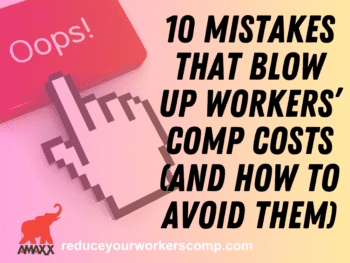As the risk manager for your mid-size company, you want to consider self-insurance in the jurisdictions where you are allowed to do so. But your company is mid-size, not a Fortune 500 company. While you have the resources to handle most workers’ compensation claims, you are concerned a catastrophic work comp claim could do serious damage to your company’s current and long-term financial outlook. The solution is the excess workers’ compensation insurance carrier.
What is Excess Workers’ Compensation Insurance?
A workers’ compensation excess insurance policy is written to indemnify the self-insured employer for workers’ compensation claims (and Employers’ Liability claims) exceeding a designated dollar amount. The excess work comp insurance covers all work comp losses up to a specified cap, or it can be unlimited.
Click Link to Access Free PDF Download
For example, you decide your company can afford the cost of paying almost all work comp claims but do not want to be on the hook to pay claims where the total cost exceeds the company’s set $500,000 limit. The way to handle the rare catastrophic work comp claim is to buy excess workers’ compensation insurance. The excess workers’ compensation insurer indemnifies your company only on those claims exceeding $500,000 in total cost.
Layers of Coverage
The excess workers’ compensation insurance carrier may be willing to insure some risk but does not want to have unlimited medical exposure on your work comp claims. They may put a cap on their exposure, for example, $1,000,000 is the most they are willing to pay over and above the $500,000 your company pays on a catastrophic injury claim. You will then need another excess policy over and above the “second layer of coverage” (the self-insurance being the first layer of coverage). The second excess workers’ comp carrier only reimburses your company for claims exceeding $1,500,000 (and is the third layer of coverage).
The first excess workers’ comp insurance carrier may be willing to write all your coverage over and above your cap. If they do agree to take on the unlimited medical exposure on your catastrophic injury claims, the excess workers’ compensation insurer will, in turn, most likely have a policy of reinsurance in with another insurance company.
That is, they will buy another insurance policy from another insurer to cover all their losses over and above a set dollar limit, say $1,500,000 per claim. Or they may cede the other insurance company, i.e., give the other insurance company part of your premium in exchange for the other insurance company’s promise to pay any claims over and above the agreed upon dollar amount.
Benefits of Excess Workers’ Compensation Insurance
Besides the obvious benefit of being reimbursed for catastrophic work comp claims exceeding your self-insurance cap, excess workers’ compensation insurance provides additional benefits to your company.
Most self-insurers are not able to be self-insured without the excess workers’ compensation policy. Self-insurance allows the risk manager more control over the cost of the insurance program, more control over the claims handling, and improves the cash flow by lowering the cost of workers’ comp insurance (by eliminating the profit portion of the premium paid to a first dollar insurance carrier).
Often the excess workers’ compensation insurer offers the self-insured employer additional services and works as a partner with the self-insured. Some of the services offered by the excess work comp insurer may include:
- Underwriting guidance
- Guidance in meeting the regulatory requirements
- Industry-specific loss control services to assist in managing workplace hazards
- On-site safety assessments
- Best practices for managing work comp claims
- Emergency planning and preparation
- Catastrophic claim management
FREE DOWNLOAD: “Step-By-Step Process To Master Workers’ Comp In 90 Days”
What to Look For in Selecting an Excess Workers’ Compensation Insurer
In addition to the services noted above, look for an excess insurer which includes the allocated loss adjustment expenses (the cost of handling the claims) in the definition of loss per claim, not just what is paid to the employee in benefits.
Also, if your company is exposed to longshore and harbor workers claims, Jones Act claims, railroad work comp, coal mine, or migrant and seasonal workers, be sure your excess workers’ comp insurer covers these types of claims. (Some excess policies exclude some or all of them).
You want an excess workers’ comp carrier whose is flexible in their underwriting, that is they will allow your company to set your self-insurance retention cap, and are willing to endorse their policy to eliminate exclusions that might affect your coverage.
Correctly managed, a self-insurance program in conjunction with an excess workers’ comp insurance policy can provide your company with the work comp coverage you need while saving your company part of the cost of workers’ compensation.

Contact: mstack@reduceyourworkerscomp.com.
Workers’ Comp Roundup Blog: https://blog.reduceyourworkerscomp.com/
©2018 Amaxx LLC. All rights reserved under International Copyright Law.
Do not use this information without independent verification. All state laws vary. You should consult with your insurance broker, attorney, or qualified professional.
FREE DOWNLOAD: “Step-By-Step Process To Master Workers’ Comp In 90 Days”













